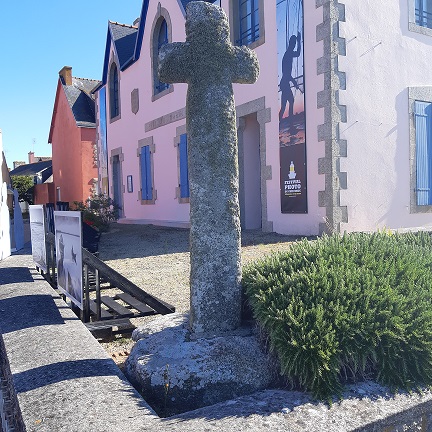
Des cicatrices circulaires sur le platier rocheux du Guilvinec, entre le mole-abris à la pointe de Men-Meur, et au-delà sur la Grève Blanche, prouvent l'existence d'une carrière de socle de croix ou de meule. Plusieurs centaines sont réparties sur toute la côte et les plus anciennes datent du XIIème siècle. Ce granit du Pays Bigouden et de la côte sud de la Bretagne est réputé pour sa robustesse.
Ici, la roche, un granit à gros grains et deux micas (blanc et noir) est très favorable à l'extraction car les fissures sont très proches de l'horizontale.
Le grain d’un granite désigne la grandeur moyenne des plages constituées par une association de minéraux de même nature. On distingue les catégories suivantes : - granite à très gros grain : grain supérieur à 10 mm ; - granite à gros grain : grain de 3 à 10 mm ; - granite à grain moyen : grain de 2 à 3 mm ; - granite à grain fin : grain de 0,5 à 2 mm ; - granite à grain très fin : grain inférieur à 0,5 mm ; - microgranite : grain seulement visible au microscope avec parfois quelques grands cristaux visibles à l’œil nu.
________________________________________________________________
Circular scars on the rocky plateau of Guilvinec, between the mole-abris at the point of Men-Meur, and beyond on the Grève Blanche, prove the existence of a quarry of a cross or a millstone. Several hundred are spread over the entire coast and the oldest date from the 12th century. This granite from the Pays Bigouden and the southern coast of Brittany is renowned for its robustness.
Here, the rock, a coarse-grained granite and two micas (white and black) is very favorable for extraction because the cracks are very close to the horizontal.
The grain of a granite refers to the average size of the beaches formed by an association of minerals of the same nature. The following categories are distinguished: - very coarse granite: grain greater than 10 mm; - coarse-grained granite: grain from 3 to 10 mm; - medium grain granite: grain of 2 to 3 mm; - fine-grained granite: grain of 0.5 to 2 mm; - very fine-grained granite: grain less than 0.5 mm; - microgranite: grain only visible under a microscope with sometimes a few large crystals visible to the naked eye.
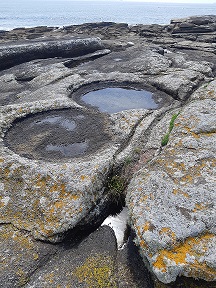
Cette activité d'extraction fonctionnait depuis le bas moyen-âge jusqu’ au XVII siècle, grande période d'édification de croix le long des chemins du Pays Bigouden. Elle tire partie d'une roche très favorable : le granite à gros grain et à deux micas (blanc et noir), dont l'orientation des fissures est proche de l'horizontale.
________________________________________________________________
This extraction activity operated from the late Middle Ages until the 17th century, a great period of construction of crosses along the paths of the Pays Bigouden. It takes advantage of a very favorable rock: coarse-grained granite and two micas (white and black), whose orientation of the cracks is close to the horizontal.
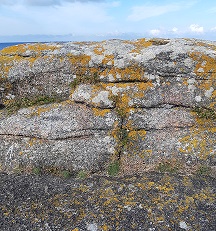
Les Questions / The Questions
Les socles de croix de Men-Meur,
Questions à valider
Question 1: Ce granit est composé de deux types de mica, quels sont-ils ?
Question 2 : A la lecture du descriptif, et une observation sur le terrain, expliqué par vos propres mots, pourquoi ce site est favorable à l'extraction de blocs de pierres ?
______________________________________________________________________________________________
Questions to validate: The bases of the cross of Men-Meur,
Question 1: This granite is made of two types of mica, what are they?
Question 2: After reading the description, and an observation in the field, explained in your own words, why this site is favorable to the extraction of stone blocks? ______________________________________________________________________________________________
Question 3 : Sur la photo ci-dessous, à l'emplacement du disque de rouge, quelle est la particularité de cette excavation ?
Question 3: On the photo below, at the location of the red disc, what is the particularity of this excavation?
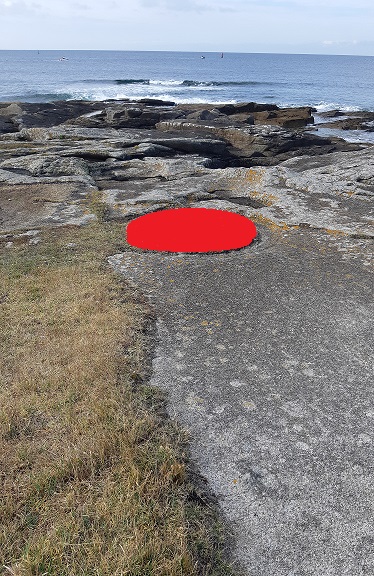
Question 4 : Prenez une photo (en Noir et Blanc de préférence) de vous, ou d'un élément vous identifiant, avec comme toile de fond le gros rocher (qui fait fonction d'amer pour les marins) en granit à gros grains peint en blanc sur votre la droite en regardant la mer.
_________________________________________
Question 4: Take a photo (preferably in Black and White) of yourself, or of an element that identifies you, with as a backdrop the large boulder (which acts as a bitter for sailors) in coarse-grained granite painted in white on your right looking at the sea.
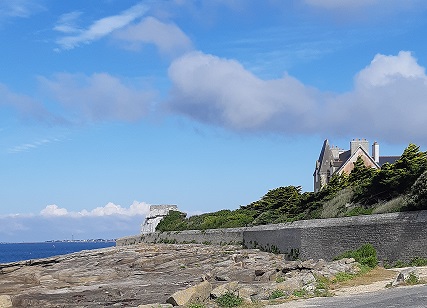
Vous pouvez vous loguer sans attendre notre confirmation, mais vous devez nous envoyer les réponses en même temps soit par mail via notre profil (bigouden1729), soit via la messagerie geocaching.com (Message Center).
S'il y a des problèmes avec vos réponses nous vous en ferons part. Les logs enregistrés sans réponses seront supprimés.
---------------------------------------------------------------------------------------------------------------------------------------------
You can log in without waiting for our confirmation, but you must send us the answers at the same time either by email via our profile (bigouden1729), or via geocaching.com (Message Center).
If there are any problems with your answers we will let you know. Logs recorded without response will be deleted.